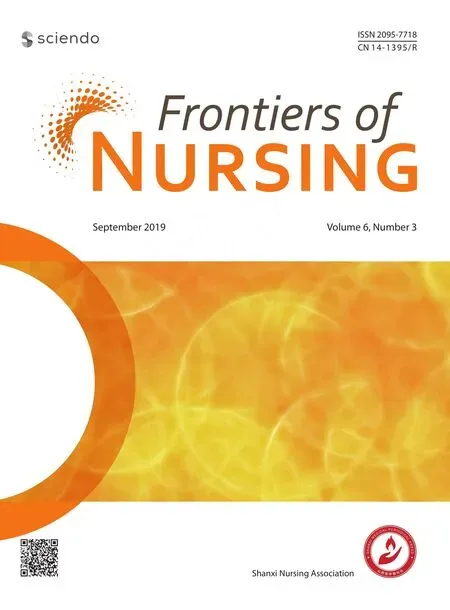Investigation and analysis of attitudes and knowledge of aging among students in different majors
Li-Mei Zhao, Li-Ling Xie, Yan Wang
School of Nursing, Tianjin University of Traditional Chinese Medicine, Tianjin 301600, China
Abstract: Objective: To investigate the attitude and knowledge score of the elderly in different majors.Methods: A total of 265 students were surveyed by self-designed questionnaire that consists of three parts: general information,Kogan's attitude toward older people (KAOP) scale, and knowledge questionnaire.Results: There were signif i cant differences between the attitudes of the elderly and the aging knowledge scores for students who have taken care of the elderly and who have been cared for by their grandparents (P = 0.04; P = 0.02). Students who had experience in caring for the elderly scored higher. Students who were taken care of by their grandparents during the childhood were more active in the elderly. The scores of attitudes appreciation and attitude scores of elderly were statistically signif i cant between nursing students and non-nursing students (P = 0.01; P = 0.03), and the non-nursing students' attitude appreciation and attitude scores were higher than those of nursing students.Conclusions: The nursing students have a more positive attitude to the elderly, but the level of aging knowledge is lower and lower than that of non-nursing students, which should be further improved.
Keywords: undergraduate students · nursing · the elderly · attitude · aging knowledge
1. Introduction
Since 2015, China has entered the stage of rapid development of the aging population. At the end of 2016,the population of 60-year-olds and older has reached 231 million, accounting for 16.7% of the total population.1The increase in the elderly population and the “421”family model have led to a sharp increase in the demand for aged care. As the reserve army of the future elderly nursing talents, as the main caregivers of the elderly in many fi elds, such as hospitals, communities, and pension institutions, the nursing students' attitude to the elderly and the degree of their knowledge of aging affect their willingness to work in aged care2and high quality care for the elderly.3Therefore, this study takes nursing students and non-nursing students as the research object and compares them with the purpose of understanding the attitude of the elderly and the knowledge of aging knowledge about nursing students. Through the analysis of the inf l uencing factors, this study will provide a reference for the better development of nursing education for the elderly in the future.
2. Subjects and methods
2.1. Subjects
From February to May 2018, the researcher himself facilitated the extraction of 131 nursing students from Tianjin Medical College and 134 non-medical students from non-medical colleges (hereinafter referred to as non-nursing students), aged 18-23 years old(20.63 ± 1.17). All of them are full-time undergraduate students (61 males and 204 females), and 265 respondents volunteered to participate in the study.options; the correct answer to the even number question is “right”, 1 points, and the other options are 0 points. Score ranges from 0 to 25 points,the higher the score, the higher the level of aging knowledge. The Cronbach's α coefficient of the questionnaire was 0.714, with good reliability and validity.5
2.2. Methods
2.2.1. Survey tool
The questionnaire was composed of three parts: a selfedited general information questionnaire, Kogan's attitude toward older people (KAOP) scale, and the aging knowledge questionnaire.
(1) The self-edited general information questionnaire included 7 items: gender, place of origin,whether he/she is an only child, and whether there is an elderly care experience, whether living with the elderly, whether he/she is taken care by their grandparents and whether to participate in volunteers activity.
(2) The elderly attitude scale (KAOP): a translated and revised Chinese version of the attitude toward the elderly,4which is divided into two dimensions of appreciation and prejudice,17 entries per dimension. Using the Likert sixlevel scoring method, the positive entry scores were 1, 2, 3, 5, 6, and 7 points, and the negative entries are scored in reverse order. A score of 136 points indicates a neutral attitude, a score of >136 points indicates a positive attitude, and a higher score indicates a more positive attitude.The total Cronbach's α coefficient of the scale is 0.848, the Cronbach's α coefficient of the appreciation dimension is 0.816, and the Cronbach's α coefficient of the bias dimension is 0.814.5
(3) The aging knowledge questionnaire: the revised Chinese version of the aging knowledge questionnaire was translated on the senological knowledge test scale (FAQI) compiled by Palmore in 1977. The content involves the knowledge of physiological, psychological, and social aspects of the elderly. There are 25 items. Use the three options “right, wrong, and unknown”to score, of which the correct answer to the odd number is “wrong”, 1 points and 0 points for other
2.2.2. Data collection method
Before the investigation, the researcher explained the purpose and method of the survey to the respondents,and explained the fi lling methods and matters needing attention of the questionnaire. The anonymous method was used to fi ll in, and the researcher was handed out on the spot and recovered on the spot. A total of 280 questionnaires were distributed and 265 valid questionnaires were collected, with an effective recovery rate of 94.64%.
2.2.3. Statistical method
The SPSS19.0 software was used to record and analyze the recovery data, and measurement data are expressed as mean ± standard deviation (M ± SD).The count data are expressed by frequency and percentage, and the data were analyzed by independent sample t-test. The difference was statistically signif i cant at P < 0.05.
3. Results
3.1. Comparison of attitudes between nursing students and non-nursing students with different demographic characteristics and life experiences
There was a statistically signif i cant difference in the scores of attitude bias in the elderly with the experience of the elderly (P = 0.04), the students who have the experience of caring for the elderly have a higher score. There was a statistically signif i cant difference in the scores of attitudes of the elderly relatives who were cared for by the (outside) grandparents (P = 0.02), and the students who were cared for by the (outside) grandparents were more active toward the elderly. Other items were not statistically signif i cant (P > 0.05), see Table 1.
3.2. Comparison of aging knowledge scores of students with different demographic characteristics and life experiences
There is a signif i cant difference in the score of aging knowledge for the students who have the experience of caring for the elderly (P = 0.02). There is a high score of aging knowledge for the students who have the experience of caring for the elderly, and there is no statistical signif i cance in other items (P > 0.05), see Table 2.
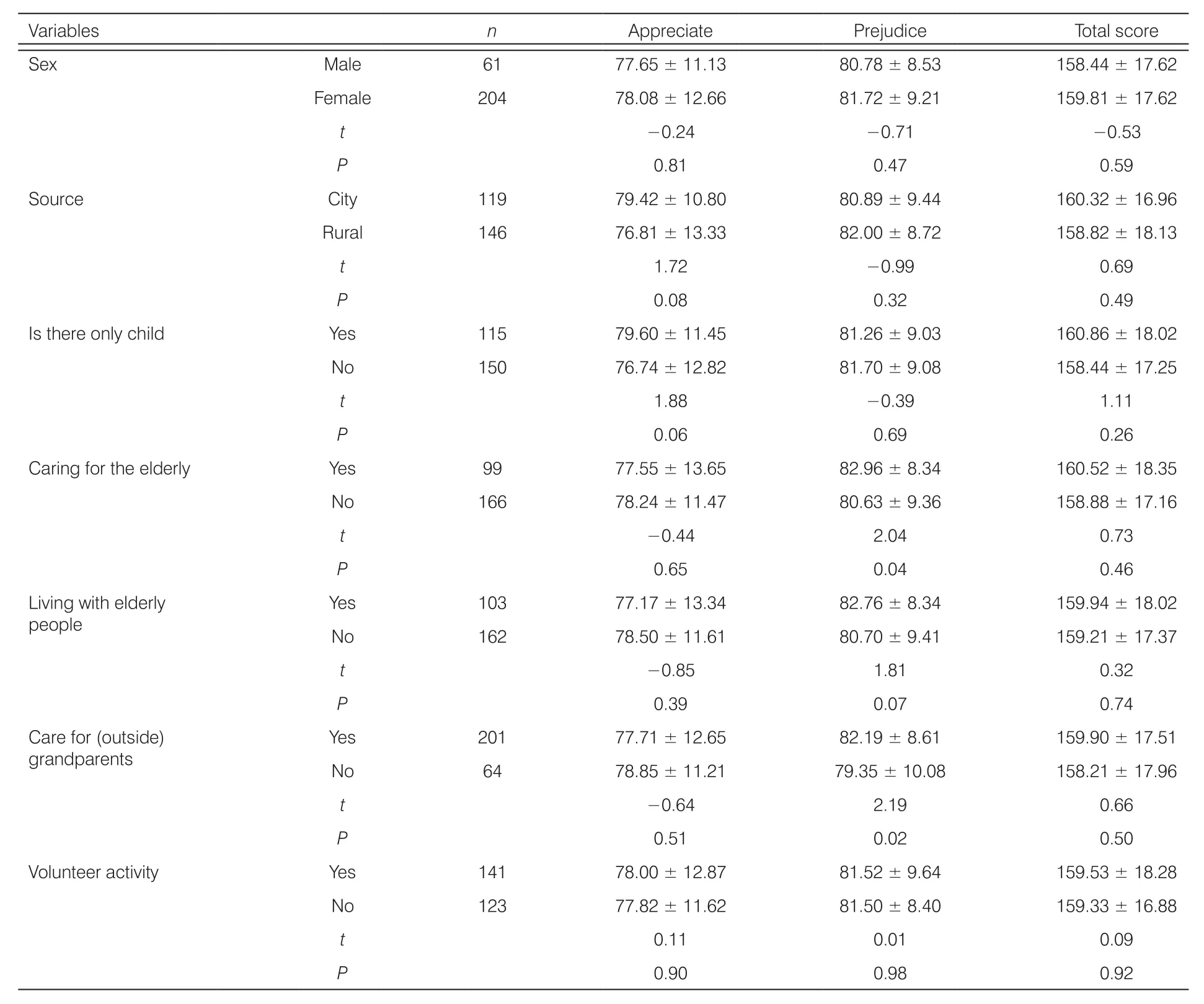
Table 1. Comparison of attitudes of students with different demographic characteristics and life experiences on the elderly
3.3. Comparison of attitude and aging knowledge between nursing students and non-nursing students
There was a signif i cant difference in the scores of attitudes appreciation dimension between the nursing students and non-nursing students (P = 0.01). The scores of non-nursing students' attitude appreciation of the elderly were higher than those of the nursing students.There was a statistically signif i cant difference in the total scores of the attitudes between the nursing students and the non-nursing students (P = 0.03), and the nonnursing students' attitude toward the elderly was higher than that of the nursing students. There was no signif icant difference in the scores of prejudice between nursing students and non-nursing students on the attitudes of the elderly (P > 0.05), see Table 3.
3.4. Multifactorial analysis of the in fl uence of nursing students and non-nursing students on the elderly
According to the results of a single-factor analysis, four factors, the source of the birthplace, whether he/she is the only child, whether there is an experience in caring for the elderly, and whether have you ever had (outside)grandparents care, are independent variables, and the attitude of nursing students and non-nursing students to the elderly is a dependent variable, a multivariate stepwise regression analysis was performed. The results show that there are two factors that enter the regression model (see Table 4).
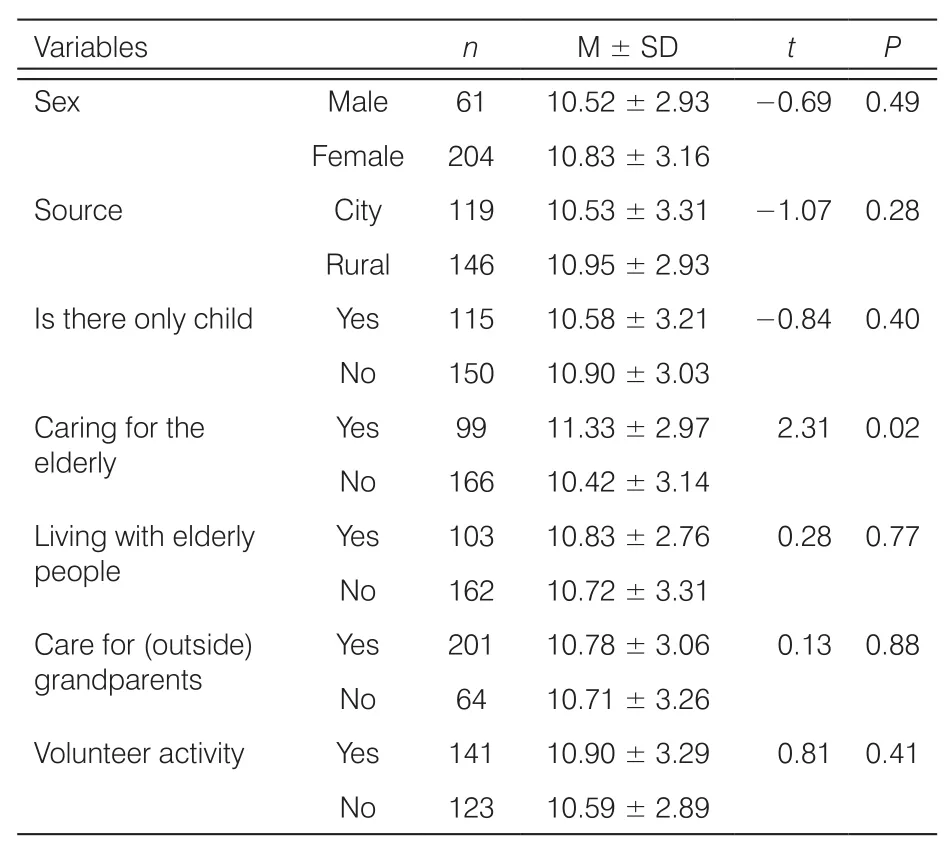
Table 2. Comparison of student aging knowledge scores ofstudents with different demographic characteristics and life experiences
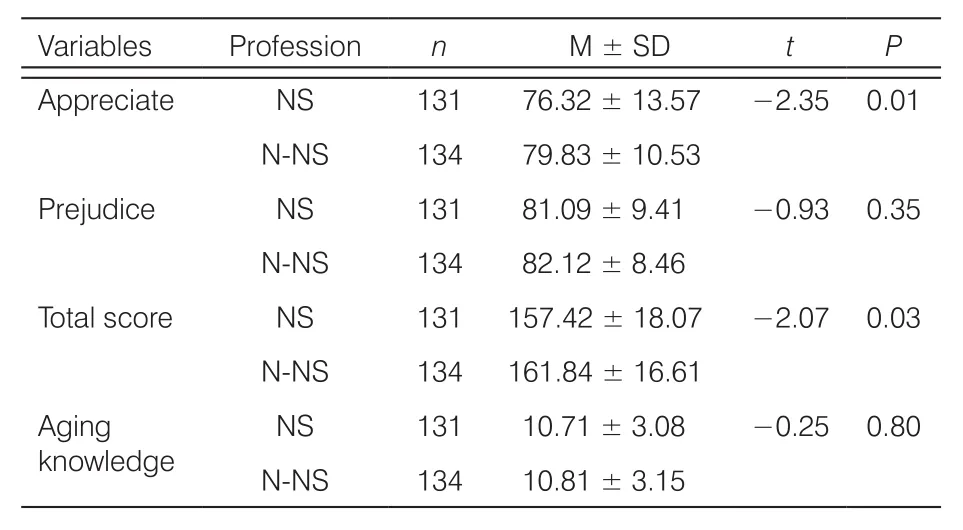
Table 3. Comparison of scores of attitude and aging knowledge among nursing students and non-nursing students
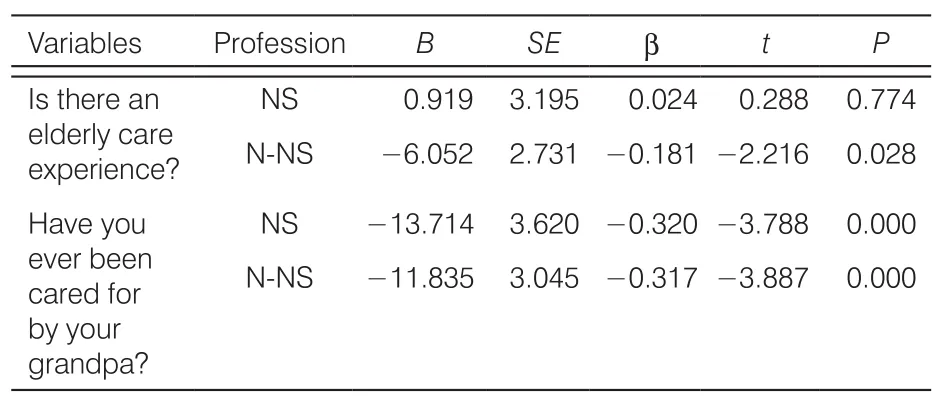
Table 4. Multiple linear regression analysis of the inf l uence of occupational willingness of nursing students and non-nursing students
4. Discussion
The attitude toward the elderly is def i ned as beliefs and feelings toward the elderly.6The fi ndings of this study show that nursing students' attitudes toward the elderly are positively biased (157.42 ± 18.07), this is consistent with the fi ndings of domestic and foreign researchers.7-9The scores of non-nursing students are signif i cantly higher than nursing students. This may be because the Chinese nation's fi ne tradition of respecting the elderly and loving the old is deeply rooted in the fi lial piety culture of every Chinese son and daughter, and both the nursing students and the non-nursing students have received fi lial education in all aspects of family, school, and society. The high level of cultural literacy makes it more positive for the elderly. Sun et al.8thought that there are differences in the explicit and implicit attitudes of nursing students toward the elderly and implicit negative stereotypes for the elderly. Yu10believes that this is related to Chinese traditional culture and education. We need to further explore college students' attitudes toward the elderly.
Aging knowledge is the cognition of declarative knowledge, such as the gradual decline of physiological functions, the diminishing psychological function, the transformation of social roles, and the decline of social status in the long process of human beings from maturity to aging.11In this study, the scores of nursing students'knowledge of aging were lower (10.71 ± 3.08), and the cognition level of aging knowledge was relatively low.It is lower than Sun et al.'s12survey results of undergraduate nursing students in Chinese medicine colleges(15.37 ± 2.92). This shows that although the nursing students have received medical education in the courses related to geriatric nursing, they have not achieved good teaching results. The aging knowledge level of nursing students is at a low level, which is in contradiction with the large demand for aged nursing talents in China. All colleges and universities should improve their teaching programs and make correct guidance for nursing students to enter the old-age care industry.
Whether there is experience in caring for the elderly and whether they are taken care of by their grandparents when they are young are the factors that affect the attitude of the nursing students and non-nursing students. The KAOP scores of nursing students and non-nursing students who were taken care of by their grandparents during their childhood were higher than those of their parents who did not have grandparents.Due to the current social and economic development and transformation in China, the “421” family model has appeared in large numbers, and more and more children are being cared for by (outside) grandparents.The long time and companionship of grandparents and grandchildren make the relationship between grandparents and grandchildren close, thus changing the attitude of the nursing students to the elderly, which is consistent with the study of Wu.13Cognitive development theory also believes that young people who have been cared for by their (outside) grandparents tend to make higher evaluations of older people.14Whether there is experience in caring for the elderly, there is a difference in the KAOP effect between nursing students and non-nursing students. It is possible that the nursing students may take care of the elderly more from the elderly who are in hospital, but the elderly who take care of by the nonnursing students are mostly their own elders, so the attitude toward the elderly is more positive.
5. Conclusions
In the aging society, the degree of nursing students'attitude to the elderly and the knowledge of aging is an important factor affecting the nursing students' ability to go to the elderly nursing-related posts, and is also the basic condition for the nursing students to become the high-quality nursing talents for the elderly. Medical colleges should pay attention to the education of aged care for nursing students. Do not limit themselves to the care of the elderly, which may lead to a more negative attitude toward the elderly. We should pay attention to train the positive attitude of the nursing students to the elderly and the skills to communicate with the elderly. In class,we can use diversif i ed teaching methods to enrich the case of the elderly. During probation, nursing students can contact different elderly people in different situations such as nursing homes, hospitals, communities, and families so that nursing students can go deep into the life of the elderly. It can not only fi nd cases that are different from the straight-line development of books but also exercise the ability of aged care, understand the care needs of the elderly, and enrich the knowledge of aging.As the nursing students improve their attitudes toward the elderly and their knowledge of aging, their willingness to engage in aged care work will also increase.
Ethics approval
This study was approved by the Ethics Committee of Tianjin University of Traditional Chinese Medicine. Written informed consent was obtained from all of the experts.
Conf l icts of interest
All contributing authors declare no conf l icts of interest.
- Frontiers of Nursing的其它文章
- Inf l uence of physical self and mindfulness on the academic possible selves of freshman nursing students
- Research status and hotspots of economic evaluation in nursing by co-word clustering analysis
- Analysis of the application and practice of PDCA cycle in management of the naked medicine dispensing—the quality and safety of the drug
- The effect of empowerment education on depression level and laboratory indicators of patients treated with hemodialysis: a meta-analysis
- Effectiveness of integrated nursing interventions for fatigue in patients with advanced cancer: a systematic review of randomized controlled trials
- The eligibility criteria, training content, and scope of practice for prescriptive authority for midwives: a modif i ed Delphi study†

